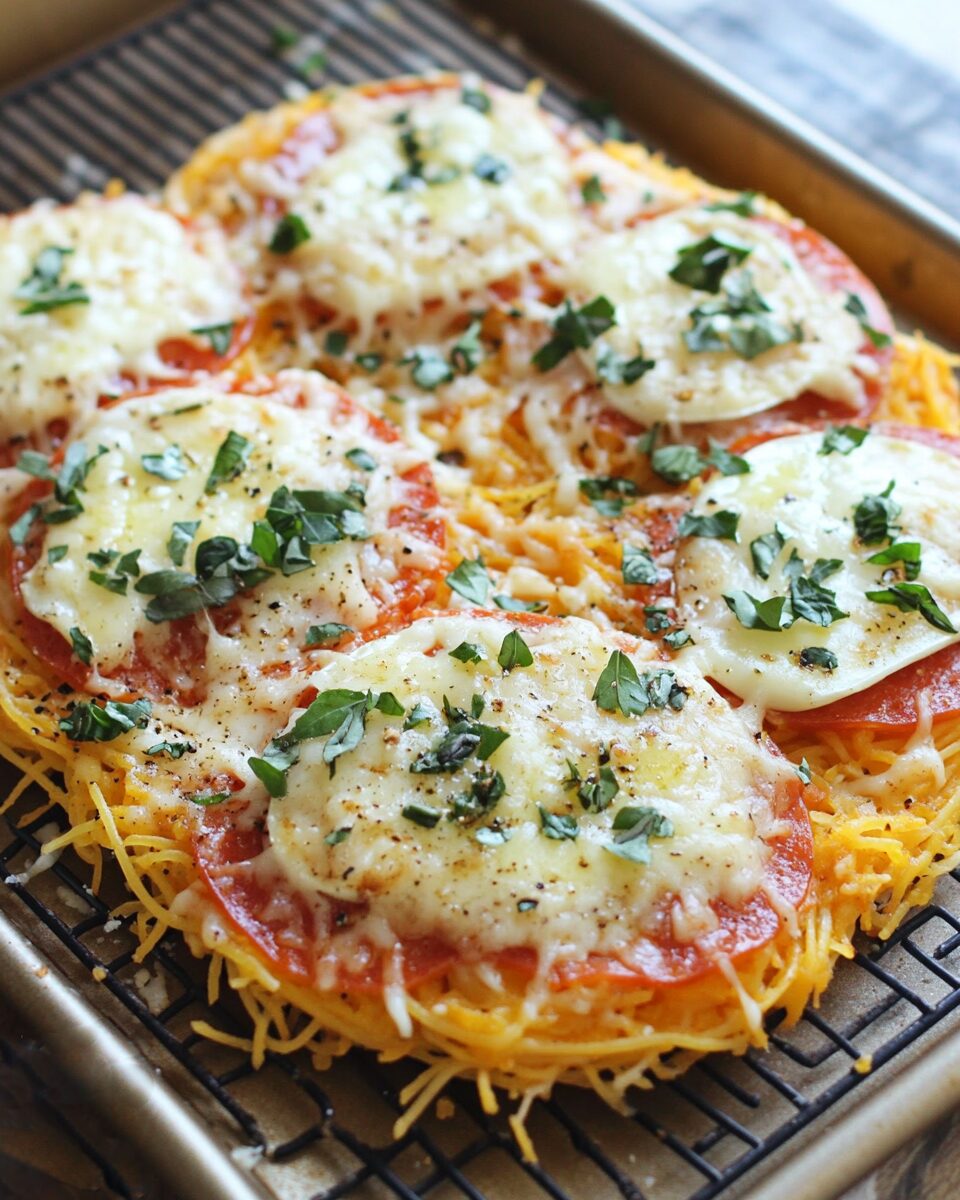The spaghetti squash pizza crust is a clever, low-carb alternative to traditional pizza dough that still delivers all the crispy satisfaction you crave. By squeezing out excess moisture and combining it with cheese and spices, you get a crust that holds up beautifully under your favorite toppings. Perfect for those following gluten-free, keto, or low-carb lifestyles, this crust is easy to prepare and endlessly customizable. Whether you love classic pepperoni or a veggie-loaded slice, this spaghetti squash base has you covered for a lighter, guilt-free pizza night the whole family will love.
Full Recipe:
Ingredients:
-
2 cups cooked spaghetti squash (well-drained)
-
1/2 cup grated Parmesan cheese
-
1/2 cup part-skim mozzarella cheese
-
1 large egg
-
1/2 tsp dried oregano
-
1/2 tsp garlic powder
-
1/4 tsp salt
-
Optional toppings: pizza sauce, mozzarella cheese, turkey pepperoni, mushrooms, peppers, onions
Directions:
-
Preheat oven to 400°F (200°C). Line a baking sheet with parchment paper.
-
If using freshly cooked spaghetti squash, let it cool completely and squeeze out as much moisture as possible using a cheesecloth or clean kitchen towel.
-
In a mixing bowl, combine spaghetti squash, Parmesan, mozzarella, egg, oregano, garlic powder, and salt. Mix well until fully incorporated.
-
Spread the mixture onto the prepared baking sheet and shape it into a round or rectangular pizza crust, about 1/4 inch thick.
-
Bake for 25 minutes or until the crust is golden brown and firm to the touch.
-
Remove from the oven and add desired toppings. Return to the oven and bake for an additional 10 minutes or until the cheese is melted and bubbly.
-
Let cool slightly before slicing and serving.
Prep Time: 15 minutes | Cooking Time: 35 minutes | Total Time: 50 minutes
Kcal: 165 kcal | Servings: 4 servings
Spaghetti Squash as a Pizza Crust
In the world of alternative eating where gluten-free, low-carb, and plant-based options are on the rise spaghetti squash pizza crust is becoming a standout favorite. It’s a wholesome, delicious, and satisfying way to enjoy pizza without the heaviness or guilt of traditional wheat-based dough. For many, discovering spaghetti squash as a crust base feels like unlocking a secret weapon for healthy home cooking.
This inventive use of a humble vegetable transforms the way we think about crust. While traditional pizza crusts rely on flour, yeast, and lengthy proofing times, spaghetti squash offers a faster, lighter, and nutrient-rich alternative that requires far less effort and still results in a crispy, golden foundation for your favorite toppings.
Why Spaghetti Squash Works So Well
Spaghetti squash is a winter squash that, when cooked, has long, thin strands resembling spaghetti noodles hence the name. It’s naturally low in calories and carbohydrates, yet high in vitamins and fiber. What makes it especially suitable for crusts is its mild flavor and ability to crisp up when drained well and combined with binding agents like egg and cheese.
When baked into a crust, spaghetti squash creates a firm yet flexible base that holds toppings without falling apart. Unlike cauliflower crusts, which often turn soggy or require a lot of wringing and added flour, spaghetti squash has a naturally drier texture when properly prepped, allowing it to crisp more easily.
Nutritional Benefits of Spaghetti Squash
From a health perspective, spaghetti squash is a powerhouse. One cup of cooked spaghetti squash contains only about 42 calories and 10 grams of carbohydrates, compared to around 200 calories and 36 grams of carbs in the same amount of cooked pasta or pizza dough. That’s a major win for anyone on a low-carb, ketogenic, or diabetic-friendly meal plan.
But it’s not just about cutting carbs. Spaghetti squash is rich in:
-
Vitamin C – supporting immune health
-
Vitamin B6 – vital for brain health and metabolism
-
Fiber – promoting digestion and satiety
-
Manganese and Potassium – essential for bone and heart health
Because of these properties, this crust can be part of a balanced diet that promotes sustained energy without the post-meal crash.
Who Is This Recipe For?
Spaghetti squash pizza crust is a great fit for a variety of lifestyles. Whether you’re gluten-intolerant, following a keto or paleo diet, watching your carb intake, or just looking for a more vegetable-forward way to enjoy pizza, this recipe checks all the boxes.
It’s also an excellent choice for parents trying to sneak more veggies into their kids’ meals or for anyone seeking to maintain the comforting experience of pizza night while sticking to wellness goals.
Customization and Topping Ideas
One of the best parts about spaghetti squash pizza crust is its versatility. Once the crust is baked, you can treat it like any traditional pizza base and add your favorite toppings. A few ideas to get you started:
-
Classic Margherita: Tomato sauce, fresh mozzarella, basil leaves, and a drizzle of olive oil
-
Meat Lover’s: Pepperoni, cooked sausage, bacon bits, and mozzarella
-
Veggie Supreme: Mushrooms, bell peppers, onions, olives, and spinach
-
Pesto Chicken: Pesto sauce, grilled chicken, cherry tomatoes, and goat cheese
-
Buffalo Style: Shredded rotisserie chicken, buffalo sauce, blue cheese crumbles, and green onions
Keep in mind that less is more when it comes to topping veggie-based crusts. Too many heavy toppings or too much sauce can weigh it down, so use toppings sparingly to maintain crispiness.
Tips for the Best Crust Texture
Spaghetti squash crust has a bit of a learning curve, especially when it comes to texture. Here are a few pro tips to help you get the perfect result every time:
1. Drain Thoroughly
After cooking the squash, it’s essential to remove as much water as possible. This is the single most important factor in getting a firm, crispy crust. Use a clean kitchen towel or cheesecloth to squeeze out excess moisture. If the squash is too wet, the crust will steam instead of crisp.
2. Don’t Skip the Cheese
The cheese acts as both a binder and a flavor booster. Parmesan adds a sharp, nutty taste, while mozzarella gives it that stretchy, pizza-like texture. Skipping the cheese or using too little may result in a crust that falls apart.
3. Prebake Before Adding Toppings
Always bake the crust fully before adding sauce and toppings. This helps it hold its shape and prevents sogginess. After prebaking, you can add your toppings and pop it back in the oven just long enough to melt the cheese and heat the toppings through.
4. Use Parchment Paper or a Silicone Mat
This prevents sticking and allows for even browning underneath. It also makes transferring the crust to a cutting board much easier once it’s baked.
How It Compares to Other Alternative Crusts
Spaghetti squash pizza crust is often compared to other popular alternatives like cauliflower, almond flour, or chickpea crusts. While all have their merits, spaghetti squash stands out for being:
-
Lower in calories and carbs than most flour-based options
-
Less labor-intensive than cauliflower crust (no steaming or excessive wringing)
-
Naturally gluten-free without added starches or binders
-
More nutrient-dense, especially in fiber and antioxidants
It’s also budget-friendly and widely available in grocery stores year-round, making it an accessible option for many households.
Storage and Meal Prep Tips
If you like to meal prep, this crust is a fantastic candidate. You can:
-
Make the crust ahead of time and store it in the fridge for up to 3 days before topping and baking.
-
Freeze the baked crust by wrapping it in parchment and placing it in an airtight container. Thaw in the fridge and bake again with toppings.
-
Use leftovers as a fun twist on breakfast pizza with an egg and avocado or turn it into a flatbread sandwich for lunch.
The crust stays surprisingly sturdy even after freezing and reheating, so don’t be afraid to make extras!
Advertisement
A Perfect Option for Family-Friendly Meals
Kids and adults alike love pizza, and this spaghetti squash crust is a great way to enjoy a comfort food favorite in a more nourishing form. Because it’s mild in flavor, it doesn’t overwhelm the taste of your toppings, making it an easy transition for picky eaters or those new to vegetable-based meals.
You can even let everyone in the family top their own mini crusts with their favorite ingredients for a fun and interactive dinner night.
Conclusion:
Spaghetti squash pizza crust is more than just a trend it’s a tasty, creative, and health-forward way to enjoy one of the world’s favorite foods. It bridges the gap between indulgence and nutrition, letting you have your pizza and feel great about it too.
Whether you’re looking for gluten-free alternatives, reducing carbs, or simply adding more vegetables into your diet, this crust delivers on flavor, texture, and satisfaction. With a little prep and the right toppings, it’s a game-changer in any healthy kitchen.

